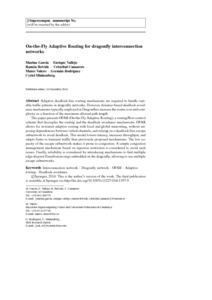Mostra el registre d'ítem simple
On-the-fly adaptive routing for dragonfly interconnection networks
| dc.contributor.author | García, Marina |
| dc.contributor.author | Vallejo, Enrique |
| dc.contributor.author | Beivide Palacio, Julio Ramón |
| dc.contributor.author | Camarero Coterillo, Cristobal |
| dc.contributor.author | Valero Cortés, Mateo |
| dc.contributor.author | Rodríguez Herrera, Germán |
| dc.contributor.author | Minkenberg, Cyriel |
| dc.contributor.other | Universitat Politècnica de Catalunya. Departament d'Arquitectura de Computadors |
| dc.date.accessioned | 2016-02-10T10:46:02Z |
| dc.date.issued | 2015-03-01 |
| dc.identifier.citation | García, M., Vallejo, E., Beivide, R., Camarero, C., Valero, M., Rodríguez, G., Minkenberg, C. On-the-fly adaptive routing for dragonfly interconnection networks. "Journal of supercomputing", 01 Març 2015, vol. 71, núm. 3, p. 1116-1142. |
| dc.identifier.issn | 0920-8542 |
| dc.identifier.uri | http://hdl.handle.net/2117/82765 |
| dc.description.abstract | Adaptive deadlock-free routing mechanisms are required to handle variable traffic patterns in dragonfly networks. However, distance-based deadlock avoidance mechanisms typically employed in Dragonflies increase the router cost and complexity as a function of the maximum allowed path length. This paper presents on-the-fly adaptive routing (OFAR), a routing/flow-control scheme that decouples the routing and the deadlock avoidance mechanisms. OFAR allows for in-transit adaptive routing with local and global misrouting, without imposing dependencies between virtual channels, and relying on a deadlock-free escape subnetwork to avoid deadlock. This model lowers latency, increases throughput, and adapts faster to transient traffic than previously proposed mechanisms. The low capacity of the escape subnetwork makes it prone to congestion. A simple congestion management mechanism based on injection restriction is considered to avoid such issues. Finally, reliability is considered by introducing mechanisms to find multiple edge-disjoint Hamiltonian rings embedded on the dragonfly, allowing to use multiple escape subnetworks. |
| dc.description.sponsorship | This work has been supported by the Spanish Ministry of Education, FPU grant AP2010-4900; the Spanish Science and Technology Commission (CICYT) under contracts TIN2010-21291-C02-02, TIN2012-34557 and TIN2013- 46957-C2-2-P; the European Union FP7 under Agreements ICT-288777 (Mont-Blanc) and ERC-321253 (RoMoL); the European HiPEAC Network of Excellence and the JSA no. 2013-119 as part of the IBM/BSC Technology Center for Supercomputing agreement. |
| dc.format.extent | 27 p. |
| dc.language.iso | eng |
| dc.subject | Àrees temàtiques de la UPC::Informàtica::Arquitectura de computadors |
| dc.subject.lcsh | Routing (Computer network management) |
| dc.subject.lcsh | Multiprocessors |
| dc.subject.lcsh | Computational complexity |
| dc.subject.other | Interconnection network |
| dc.subject.other | Dragonfly network |
| dc.subject.other | OFAR |
| dc.subject.other | Adaptive routing |
| dc.subject.other | Deadlock avoidance |
| dc.title | On-the-fly adaptive routing for dragonfly interconnection networks |
| dc.type | Article |
| dc.subject.lemac | Encaminadors (Xarxes d'ordinadors) |
| dc.subject.lemac | Multiprocessadors |
| dc.subject.lemac | Complexitat computacional |
| dc.contributor.group | Universitat Politècnica de Catalunya. CAP - Grup de Computació d'Altes Prestacions |
| dc.identifier.doi | 10.1007/s11227-014-1357-9 |
| dc.description.peerreviewed | Peer Reviewed |
| dc.relation.publisherversion | http://link.springer.com/article/10.1007%2Fs11227-014-1357-9 |
| dc.rights.access | Open Access |
| local.identifier.drac | 15578324 |
| dc.description.version | Postprint (published version) |
| dc.relation.projectid | info:eu-repo/grantAgreement/EC/FP7/321253/EU/Riding on Moore's Law/ROMOL |
| dc.relation.projectid | info:eu-repo/grantAgreement/MICINN/1PE/TIN2012-34557 |
| local.citation.author | García, M.; Vallejo, E.; Beivide, R.; Camarero, C.; Valero, M.; Rodríguez, G.; Minkenberg, C. |
| local.citation.publicationName | Journal of supercomputing |
| local.citation.volume | 71 |
| local.citation.number | 3 |
| local.citation.startingPage | 1116 |
| local.citation.endingPage | 1142 |
Fitxers d'aquest items
Aquest ítem apareix a les col·leccions següents
-
Articles de revista [1.049]
-
Articles de revista [382]


